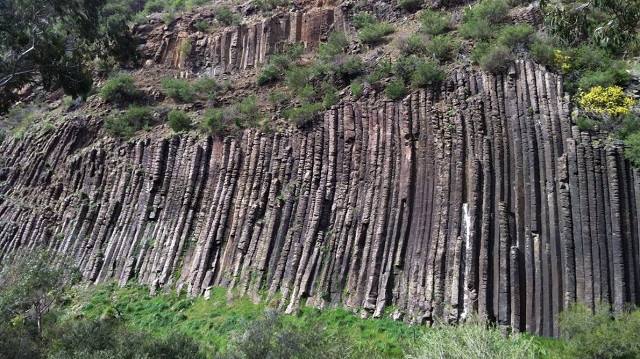Organ Pipes National Park (Keilor North)


The Organ Pipes, a set of basalt columns formed by the cooling and cracking of molten lava, are the parks best known feature. Visitors can enjoy the fantastic range of picnicking, walking, bird watching and photography opportunities available.
Enjoying the Park
Start at the Visitor Information Centre and follow the walking track to explore the many wonderful features of the park.
1. Keilor Plains
Walk through the small gate to the two viewing platforms. All around you are the basalt Keilor Plains, one of the world's largest lava flows. These plains, formed by lava which came from volcanoes near Sunbury, are fairly flat except where streams, like Jacksons Creek below you, have cut deep valleys.
2. Native plants revival
As you walk down to the Organ Pipes look closely at the trees and shrubs. In 1972 this area was covered with weeds, mainly thistles and boxthorn. Each year since the weeds have been removed more native trees and shrubs have established. The task of re-establishing native grasses and herbs has been more difficult, but there is now a substantial field of Kangaroo Grass (themeda triandra) on the north side of the track.
3. The Organ Pipes
About a million years ago, molten lava flowed over the Keilor Plains from Mount Holden and other nearby volcanic hills. It filled the depressions and valleys of the former land surface, then cooled and solidified into basalt.
Here at the Organ Pipes, it is believed that the lava filled a river valley running at right angles to Jacksons Creek and was perhaps 70 metres thick. Once a surface crust had formed, the lava beneath cooled very slowly.
During cooling, the lava contracted and surface cracks developed (as they do in a drying mud puddle). As it continued to harden, the cracks lengthened until the basalt mass was divided into columns. Over the million years since the lava flow, Jacksons Creek has cut a deep valley through the basalt and revealed the Organ Pipes.
4. Sandstone Bedrock
Walk down the stream for 200 metres, past wellestablished trees and you will see yellowish rocks across the creek. These are sandstones and mudstones, sedimentary rocks laid down under the sea. Fossils in these old rocks suggest they were formed about four hundred million years ago. The old river valley now filled by the Organ Pipes was cut in this sedimentary bedrock.
5. Rosette Rock
Now walk back upstream. About 400 metres past the Organ Pipes, look across the creek to see Rosette Rock, a radial array of basalt columns like the spokes of a wheel.
6. Tessellated Pavement
Three hundred metres further on is the Tessellated Pavement, which consists of the tops of basalt columns "filed down" by Jacksons Creek.
7. Scoria Cone
You can now return to the car park by the shortcut path shown on the map. The car park is on an eroded scoria cone - a small volcano that ejected molten volcanic rock called scoria. Scoria is reddish-brown and light in weight; it has many airholes because it was full of steam when ejected.
Facilities
Picnic tables and toilets are provided. Wood fires are not permitted but you can bring your own gas barbecue.
Opening Hours:
The park is open from 8.00am to 4.30pm each day. During the summer daylight saving period it closes at 6.00pm on weekends and public holidays.
Access for Dogs:
Dogs and other pets are not permitted.
How to get there
Organ Pipes National Park is just off the Calder Freeway about 20km north-west of Melbourne.
Review:
Three short walks are possible within the area covering one of more of the Organ Pipes wall, Rosette Rock and the Tessellated Pavement. The shortest walk to the Organ Pipes is only about 700m via a fairly steep paved road and the longest route is about 1.3 km.
It is handy to come with a dictionary but to save you the trouble a Rosette is "An ornament or badge made of ribbon or silk that is pleated or gathered to resemble a rose" and Tessellated pavement is "a geologic feature where the rock has fractured into polygonal blocks that resemble tiles, or tessellations".
Apart from the steep initial descent from the Visitor Centre, most of the walking is flat and there is a strategically placed seat part way up the hill for a rest on the return journey which can be tough, especially for little kids. Wear appropriate footwear for the return trip. Water is only available at the Visitor Centre area. Be warned that the park closes early (around 4:30 pm). Best avoided on really hot days.
Photos:
Location
Organ Pipes Road, Keilor North 3036 Map
Web Links
→ Organ Pipes National Park - Park Note (PDF)
→ Friends of the Organ Pipes - FOOPS on Facebook
→ Organ Pipes National Park - Heritage Story (PDF)











